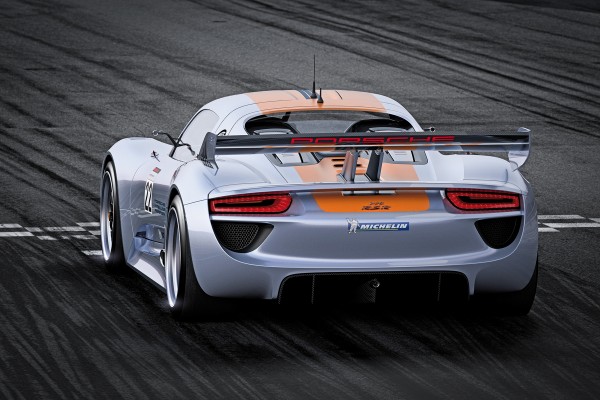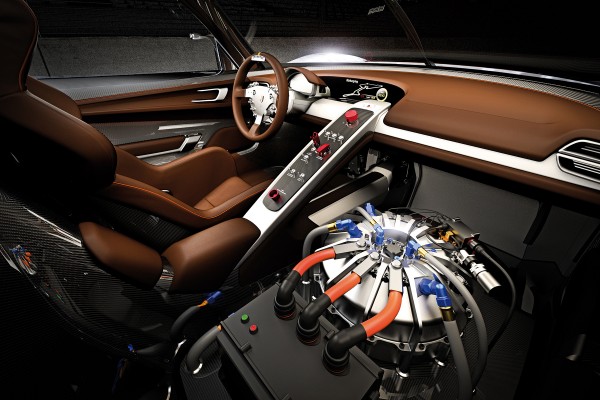What started as a simple, and perhaps offhand, remark during an interview with Bloomberg about Porsche’s return to Detroit – “We’ll have something spectacular to show there.” – by Porsche spokesman Hans-Gerd Bode, quickly blossomed into a hype driven guessing game by the automotive media.
Since early December speculations have run the gammet from a smaller SUV (aka the “Cajun”) to the production version of the recently introduced 918 Spyder. Here at FLATSIXES.COM we were thinking for the announcement to be truly “spectacular” it would need to be a completely new model (and definitely not the Cajun), perhaps even the succesor to the seemingly immortal 911. That was our best guess. Then, we received an invitation to Detroit from Porsche, a press kit and the pictures below (sitting on these pics for the past three days was the automotive media equivalent of having the winning lottery numbers and not being able to play them). What do you think? Spectacular enough?
Introducing the Porsche 918 RSR
This morning in Detroit Porsche introduced to the world their newest “racing labratory” in the form of a “post modern”, mid-engined Porsche 918 RSR. As a cross between the GT3 R Hybrid and the Porsche 918 Spyder Hybrid concept this new race car combines tomorrow’s technology with yesterday’s syling cues.
Porsche 918 RSR Specifications
In a departure from the norm (and possibly a result of its status of “concept” vs. production) the information provided by Porsche focus more on form rather than function. While details are a bit limited at this point, we do hope to have additional facts after the press conference. Here’s what we know at the moment:
- As introduced the new 918 RSR is a “racing laboratory” meaning Porsche is testing the RSR as a racing concept of the 918 Spyder. In other words, it is not yet a production version and we don’t know when, where or if we’ll see it on a track. We can only hope!!
- Output from the RS Spyder inspired V8 is 563 hp at 10,300 rpm and can be boosted to 767 with the additional power generated by the electric motor(s) mounted on each of the front wheels.
- The mid engine motor is integrated with a racing transmission derived from the RS Spyder race car. This further developed six-speed constant-mesh transmission with longitudinally mounted shafts and straight-toothed spur gears is operated using two shift paddles behind the racing steering wheel.
- Like the GT3 R Hybrid, additional power is generated during braking and stored in an optimised flywheel accumulator on the passenger seat. This additional power is available for “about 8 seconds” from a fully charged system and can be used strategically for overtaking, to delay pit stops or reduce the amount of fuel on board and therefor the overall vehicle weight
- The doors open obliquely upwards.
- The air intake is in the roof between the wing doors.
- Tires are no-profile racing slicks on 19″ wheels with central locking.
- The interior is unadorned racing atmosphere highlighted by glove like, figure-hugging bucket seats in brown leather.
- Gear selection is visible on the racing steering wheel and a “recuperation display” on the steering column in front of the display screen supply the pilot with information about the car and flywheel charge.
- The 918 RSR’s cockpit is split by a minimalistic console with rocker switches.
- Livery is a new “liquid metal chrome blue” color created to underscore “the sculptured curves of the forms.” This new color is highlighet with Porsche hybrid orange on the brake calipers and the body’s longitudinal stripes.
Here’s the question: Does it live up the hype? Tell us what you think by commenting below? Please, don’t hold back, is it “spectacular” enough?
Lastly, be sure to check back here often for more info, pictures, videos and other updates. We’ll be posting additional and exclusive content on our Facebook page and on Twitter so be sure to check those out too. Don’t forget, if you like what you see, be sure to “like” it on Facebook using the button at the top of this post (if you’re reading it on the site) or the link at the bottom of your email. Porsche’s full press release is below for your review.
Related Porsche Posts
Porsche 918 Spyder Hybrid gets Green Light for Production
Porsche 911 GT3 R Hybrid
Porsche 918 RSR racing laboratory with even higher-performance hybrid drive
Dr. Ing. h.c. F. Porsche AG, Stuttgart, is continuing to extend its performance and high effi –
ciency competence via intensive development work in the field of hybrid technology. With
the Porsche 918 RSR, the manufacturer of sporty premium vehicles is presenting a high-end
synthesis of 2010’s successful hybrid concepts. The two-seater mid-engine coupé 918 RSR
clearly reveals what happens when the technology fitted in the 911 GT3 R hybrid and the
design of the 918 Spyder are transferred to a modern, innovative super sports car.
With its highly-efficient flywheel accumulator, the 911 GT3 R hybrid racing car proved to be
an attention magnet during competition racing on the Nürburgring Nord schleife circuit,
during the American Le Mans Series races (ALMS) in Road Atlanta/USA and the ILMC run
in China’s Zhuhai. It demonstrated its massive performance potential under realistic motor
racing conditions against top competitors. The 911 GT3 R Hybrid, referred to internally as
the “Race Lab” actually surpassed the high expectations of Porsche Motorsport. Competi tive –
ness, high reliability and exemplary fuel efficiency combined with top performance under –
scored the Porsche technicians’ basic idea of generating additional power in an intelli gent
manner. The 911 GT3 R Hybrid obtains its additional power from its own vehicle dyna mics
when braking. Porsche is now transplanting this technology into the mid-engine coupé 918
RSR, the motor sports version of the 918 Spyder concept car.
From the tradition established by classic Porsche long-distance race cars such as the 908
long-tail coupé (1969) and the 917 short-tail coupé (1971), the Porsche designers created
a link to the postmodernism of the “form follows function” philosophy. In the 918 RSR, the
lines’ elegant flow is dominated by muscular wheel arches, dynamic air intakes and a pulpitlike
cockpit. A visible fan wheel between the ram air intake tubes and a rear spoiler with
RS Spyder dimensions additionally emphasise the racing laboratory function. The new “liquid
metal chrome blue” colour which has been created underscores the sculptured curves of
the forms, whilst the typical Porsche hybrid orange colour on brake calipers and the body’s
longitudinal stripes lends remarkable touches.
Motor racing technology also dominates within the particularly light, torsionally stiff carbon
fibre-reinforced plastic (CFRP) monocoque. The V8 engine is a further development of the
direct injection engine from the successful RS Spyder race car and now offers an output of
precisely 563 hp at 10,300 rpm in the 918 RSR. The electric motors on the two front wheels
each contribute 75 kW, i.e. a total of 150 kW, to the peak drive power of exactly 767 hp.
This additional power, which is generated during braking, is stored in an optimised flywheel
accumulator.
In the 918 RSR, the two electric motors offer a torque vectoring function with variable torque
distribution to the front axle. This additionally increases agility and improves steering response.
Mounted upstream of the rear axle, the mid-engine is integrated with a racing transmission
also based on the RS Spyder race car. This further developed six-speed constant-mesh trans –
mission with longitudinally mounted shafts and straight-toothed spur gears is operated using
two shift paddles behind the racing steering wheel.
The vehicle’s functional equipment underscores its puristic motor racing character. Whether
it be the characteristic doors which open obliquely upwards, the air intake in the roof bet –
ween the wing doors, the quick-action locks on the front and rear CFRP lids, the two roofmounted
aerials for pit radio and telemetry, the RS Spyder-like small, lateral front flics or
the air splitters beneath the front lip or no-profile racing slicks on 19″ wheels with central
locking, the vehicle can be clearly recognised as an experimental racing laboratory.
In contrast to the 918 Spyder concept car, unadorned racing atmosphere predominates in
the interior of the 918 RSR. The figure-hugging bucket seat’s brown leather covering cites
the history of the gentleman driver; the gear flashes on the racing steering wheel and a
recuperation display on the steering column in front of the display screen supply the pilot
with information. Instead of the futuristic, ergonomically avant-garde centre console with
touch-sensitive user interface from the 918 Spyder concept car, the 918 RSR’s cockpit is
split by a minimalistic console with rocker switches. Instead of a second seat, the flywheel
accumulator is positioned to the right of the console.
This flywheel accumulator is an electric motor whose rotor rotates at up to 36,000 rpm to
store rotation energy. Charging occurs when the two electric motors on the front axle reverse
their function during braking processes and operate as generators. At the push of a button,
the pilot is able to call up the energy stored in the charged flywheel accumulator and use it
during acceleration or overtaking manoeuvres. The flywheel is braked electro mag netically
in this case in order to additionally supply up to 2 x 75 kW, i.e. a total of 150 kW, from its
kinetic energy to the two electric motors on the front axle.
This additional power is available for around eight seconds when the system is fully charged.
In the successful 911 GT3 R Hybrid, this additional power can also be used as a consump –
tion aid depending on the racing situation, e.g. to delay pit stops or reduce the fuel tank
volume and therefore the weight of the vehicle.
With the new 918 RSR racing laboratory, Porsche is now elevating this motor racing hybrid
concept to an experimental level. In the 918 RSR, “Porsche Intelligent Performance” equates
to research into methods for further sustainable efficiency improvement under the intensified conditions of the race track, lap times, pit stops and reliability – a metier in which Porsche
has been demonstrating its success for over 60 years.
Finally, the starting number, 22, pays homage to the anniversary of a further triumph. Back
in the days when overall victories in Le Mans were not yet an entirely routine matter within
the Porsche racing department, the pilots Dr. Helmut Marko and Gijs van Lennep were the
first to cross the finishing line in 1971’s 24-hour classic. The distance record set by their
Porsche 917 short-tail coupé – 5335.313 kilometres (3315.21 miles) at an average speed
of 222.304 km/h (138.13 mph) – did not remain unbeaten for an eternity, but for exactly
39 years until 2010. At the time, the 917 in the Martini colours was also an experiment and
far ahead of its time: a magnesium space frame set new standards in Porsche’s lightweight
construction domain.
[Source: Porsche Motorsport]



